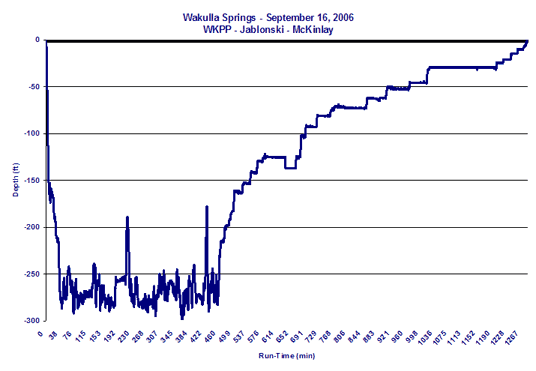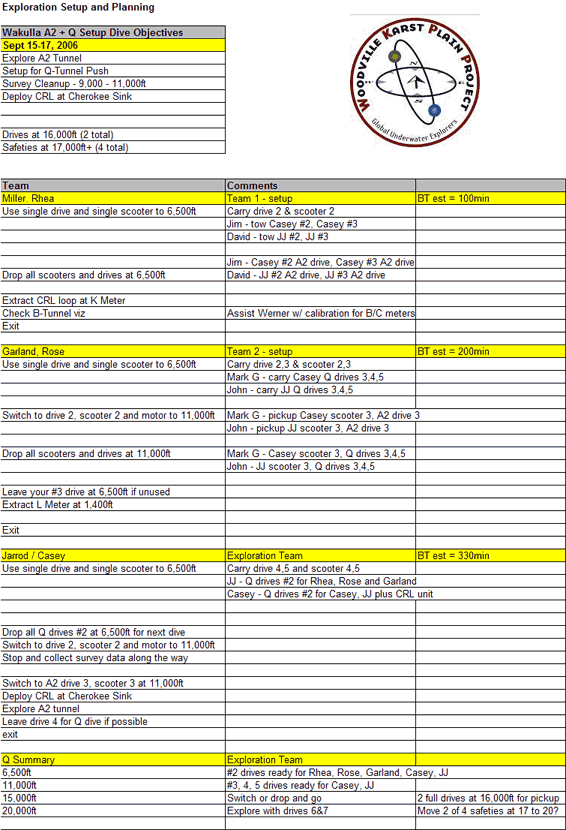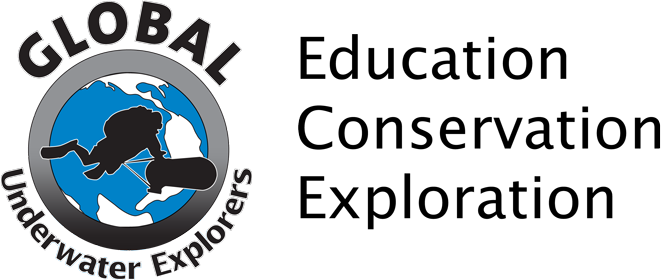WKPP – Wakulla Springs – September 15-17
WKPP – Wakulla Springs – September 15-17
While conditions remained clear in Leon Sinks, Wakulla Springs had not improved since the June 10 exploration dive to explore the northwest section of P-Tunnel. Despite dry conditions, Wakulla visibility was 50ft in the basin with high flow and would eventually deteriorate to 30ft of visibility by the end of the month. We knew open cave was waiting at 15,500ft downstream Turner Sink but the dive would be brutal even with the newly installed troughs at 70ft and 40ft. Wakulla, despite the visibility, would be preferable in that we could push west and upstream towards Turner with significantly easier setup, support and decompression logistics. We also wondered whether diving Wakulla under poor visibility conditions while Leon Sinks was clear might reveal some new information about A-Tunnel or the western section of A2 Tunnel. Lastly, we needed to take advantage of the full turnout to position additional drive bottles in the cave and if possible, transport and deploy a cave radio locator (CRL) to confirm the location of Cherokee Sink. It had been two months since we pulled the entire team together for a big event and with the forecast cooling and the tropics quiet it was time to kick off the fall season and get some work done.
Friday – September 15 - Setup
(Cox, Mudry, Canty, Bennett) Team members began arriving Friday afternoon to get the decompression equipment into the basin, prep the scooters, pack the RB80’s, interview with the film team and prepare for the long weekend ahead. Basin setup on Friday is a loose operation with the assignments falling to those support divers with more flexible work schedules. As a backup, each RB80 diver is prepared to place equipment in the event we are short on support. Fortunately, Doug Mudry, Scott Cox, Kell Canty and Derek Bennett stepped up with surface assistance from guest James Toland and got the job done. The guys did a first class job and busted ass throughout the afternoon to get all the equipment in for both of the setup teams and the exploration team. Despite a late afternoon rainstorm we finished on schedule, got some great footage and headed into the lodge for dinner.
Saturday – September 16
(Miller, Rhea) Objective – deliver 4 scooters and 4 drives to the 6,500ft drop and deploy and retrieve the FGS calibration meter from the B-Tunnel Flowmeter station. Using Halcyon RB80’s, the team made quick work of the meter assignment and delivered the goods to 6,500ft despite the poor visibility. Bottom time was 102 minutes.
Jim’s report –
Just a quick summary about our dive from Saturday
We started the dive with the predefined payload of:
We descended, did a visual on our deco bottles at 70’ and 120’, and then proceeded thru the restriction. I don’t think I need to say too much about the flow. David had the meter, and I can only imagine what that boat anchor with its arms and legs catching everything was doing since there was both no crate nor any secondary flotation on it. After getting through the restriction, we spent somewhere around 18 mins plus, going through, resting, and switching to 300 bottles. After the switch, we scootered to B Tunnel, observed the “nice clear water” and David deployed the meter. We exited and proceeded to 6500’ where we dropped our payloads and switched scooters. From there, back to K Tunnel where we picked up the transmitter), then we continued our exit. Once we reached the B Tunnel line, David took the lead, retrieved the meter, and we completed our exit. Our time on 300 gas was about 102 minutes and with the 190 stuff a total around 120 minutes. My RB80 worked great, and I had about 300-400 PSI remaining in the one bottle that I used. Around 120’ both Kell and Pina greeted us, picked up our bottles, scooters, and radio transmitter.
(Garland, Rose) Objective – deliver 6 drives to 11,000ft for the Q-Tunnel push and move 2 scooters and 2 drives from 6,500ft to 11,000ft for the A2 dive. Using Halcyon RB80’s, the team made quick work of the assignment and delivered the goods to 11,000ft.
(Jablonski, McKinlay) Objective – deliver 5 drives to 6,500ft for the upcoming Q-Tunnel exploration, deploy the CRL just past 11,000ft in the breakdown room, re-survey the 9,000ft to 11,000ft section of O-Tunnel and evaluate visibility in A2-Tunnel and a possible connection west to Leon Sinks. The task list was quite extensive for all the teams but accomplishing as much as possible this weekend would make things much easier when conditions allowed us to return and push Q-Tunnel south past 20,000ft.
Loaded with gear and flanked by the video team, we dropped over the ledge at 10:42am. I could tell it was going to be a fun dive as the visibility decreased and the flow increased as we approached the restriction at 170ft. The flow was howling and after 2 attempts to make it through the restriction loaded with equipment I signaled Derek Bennett to grab some gear to reduce drag. We met up on the other side and Derek transferred 4 tanks back to me before returning to his video assignment. Jarrod and I passed David Rhea and Jim Miller beginning their decompression, dropped the 190’s and headed out for 6,500ft. Loaded with gear in massive cave passageway and low visibility makes for a patient and focused 60 minute journey to 6,500ft; A-Tunnel right wall to 2,200ft, crossover to the left wall through the D-Tunnel junction, left line at the finger rock, past the 3,500ft safeties, right into K-Tunnel, up the K rise past the Flowmeter, 15 painful minutes following the line on the ceiling, drop back into the chamber, left at the big Rhea/Rose/Garland arrow at O junction and arrival at the 6,500ft rock. Piece of cake.
We dropped the Q-Tunnel drives, switched to fresh drives and scooters and motored to 11,000ft. We passed Mark and John near 8,500ft and from the signals we could tell the goods had been delivered. Jarrod and I picked up fresh drives and scooters at 11,000ft and motored to the breakdown room for deployment of the CRL. We located a large rock in the center of the room to allow for a reasonable margin of error in the event Todd Kincaid decided to propose a 3rd monitoring well at this location. Anthony Rue, Todd Leonard, Chris Werner and the video team were positioned 250ft above with the receiver and GPS units to pinpoint the signal once we activated the unit. It took several minutes to properly level the unit and activate the transmitter. The CRL battery would transmit for 8 hours; more than enough time to pinpoint the location. Everything appeared to be functioning properly as we departed and headed west to check the lead on the far side of the room. The line sloped up along a large breakdown pile before ending at 190ft. It was obvious there was some sort of large collapse above but there were no indications along the breakdown pile of any debris from the surface. Cherokee Sink was quite large and had been thoroughly checked over the years but there was no passable tunnel into the cave system. At that point I signaled Jarrod that I would resurvey back as far as necessary to confirm the exact location of the A2-Tunnel lead. We picked up our gear at 11,000ft and traveled back out O-Tunnel. Jarrod located the A2-Tunnel intersection as I wrapped up the survey and switched to the video scooter. We were both curious as to what we might find as WKPP explorers traveled into A2-Tunnel for the first time in almost 9 years.
O-Tunnel visibility was 20ft and tannic and for the first 500ft into A2 the visibility was equally poor. We rounded a corner and caught glimpse of a pocket of clear, blue-green water on the ceiling. We passed several Stone survey buoys and encountered more clear water. At that point we were both getting excited about the potential implications of clear water in a western lead while the main cave was blown out. It also occurred to me as we were scootering through pockets of clear water that exploration in poor visibility, while riskier, sometimes provides information that is difficult or impossible to obtain in clear conditions. We were on to something big and we both knew it. Jarrod checked a large open area on the right but the focus was the left, western wall so we decided to press on. Visibility continued to improve and we were both surprised at the massive size of the cave passageway, huge silt mounds and crayfish everywhere. We passed a T in the line and stayed left as the tunnel became smaller and curved back to the right. Jarrod signaled to hold the line as he checked a small lead to the left. A few moments later he returned, we had a quick discussion and decided to tie-in to check it out. We dropped the extra gear, pulled the reel and double checked our backgas. Normally, checking backgas confirms a full supply since we rarely use backgas other than wing inflation but for some reason I had lost a large amount of gas out of the double 121’s. Perhaps all the commotion going through the entrance restriction caused a free flow from the second stage or perhaps a free flow along the way. Regardless, I signaled Jarrod and we had another quick discussion, stowed the reel and called it a day. The bottles were positioned for Q, CRL deployed, survey confirmed and clear water discovered in A2-Tunnel with a possible lead at the end. Life was good at the moment and the objectives clear for a full scale assault on A2 at the end of the month.
We returned to the O/A2-Tunnel junction, grabbed the gear and headed back into dark water for the return trip to 6,500ft. We knew the final 6,500ft would be rough given the decision to go with two setup teams and no cleanup team. A quick drive and scooter switch along with a fluid break and we were off and running for the door. Seemed both of us were on the same page as we approached the K-Tunnel junction and Jarrod signaled right for a run over the mountain via A-Tunnel. It had been a few years but with all the extra gear in tow and a general dislike for the K-Tunnel line placement we decided the ascent to 170ft was a reasonable trade. 40 minutes later we arrived back at the 190 drop for a total bottom time of 420 minutes. Upon completing the deep stops we maneuvered the gear towards the restriction at 170ft, plotted a pathway out to the sand slope and hit the trigger. Glad to be back.


Support
For some bizarre reason, 400+ minute bottom times in Wakulla had started to feel routine. Routine to the support team was probably not the best choice of words but as darkness began to fall on the basin everyone came together to get the job done. There was no cleanup team on the schedule so we would be the only team in the basin for the evening. Team 2 would be finishing up and out before midnight along with most of the equipment. Due to the reduced visibility in the basin and the shorter than expected bottom time, Jarrod and I pulled the equipment to 120ft, picked up the 120ft deco mix and dashed towards the 120ft trough for a snack, discussion and fresh RB80’s. We helped each other out of the primary RB80’s and settled in for an extended stop on open circuit. Soon after, the support guys dropped in and pulled the RB80’s and asked us if we needed anything. As quick as they arrived they were gone again as we wrapped up the snack break and prepared to don the deco RB80’s. Soon after we were back in the basin at 110ft and moving up the slope towards 70ft. We pulled out the MP3 players and settled into the blackness. It would be 90 minutes to 70ft and 4hours to the next trough at 50ft. Another Saturday night in the Wakulla basin.
Huge Thanks:
Chris Werner, Todd Leonard, Anthony Rue, Scott Cox, Bob Bourke, Curtis Baldwin, David Doolette, Dean Marshall, Derek Bennett, Doug Mudry, Erik Graser, Hunter Swearingen, Kell Canty, Shellie Foss, Dawn Kernagis, John Bailey, Pina Porceddu, James Toland
Notables
Shellie, Hunter and Todd for running the all day-all night surface operation
Chris Werner and Anthony Rue for locating the radio signal in the brush
Todd, Dean and John for the late night pizzas
Video – Doug Mudry, Derek Bennett, Anthony Rue
Late night – Todd, Hunter, Bob Bourke, Scott Cox and David Doolette
Summary
Clear water in A2-Tunnel was a significant discovery. The main conduit (O-Tunnel) was blowing tannic water making a productive exploration dive to Q-Tunnel unlikely until the system cleared. The plan for end of September would be to find the way west via A2 and push towards Turner Sink. The season continues.

